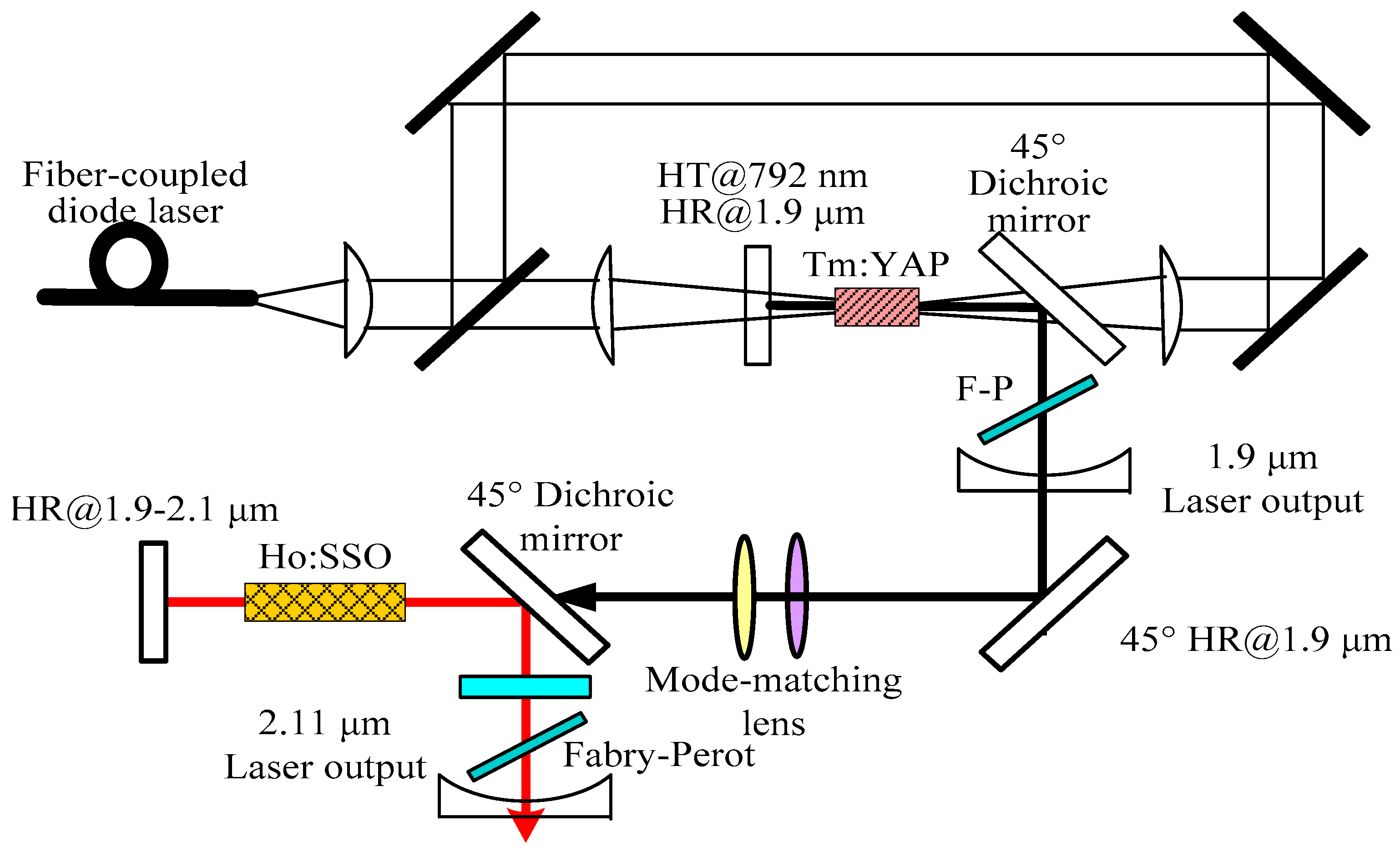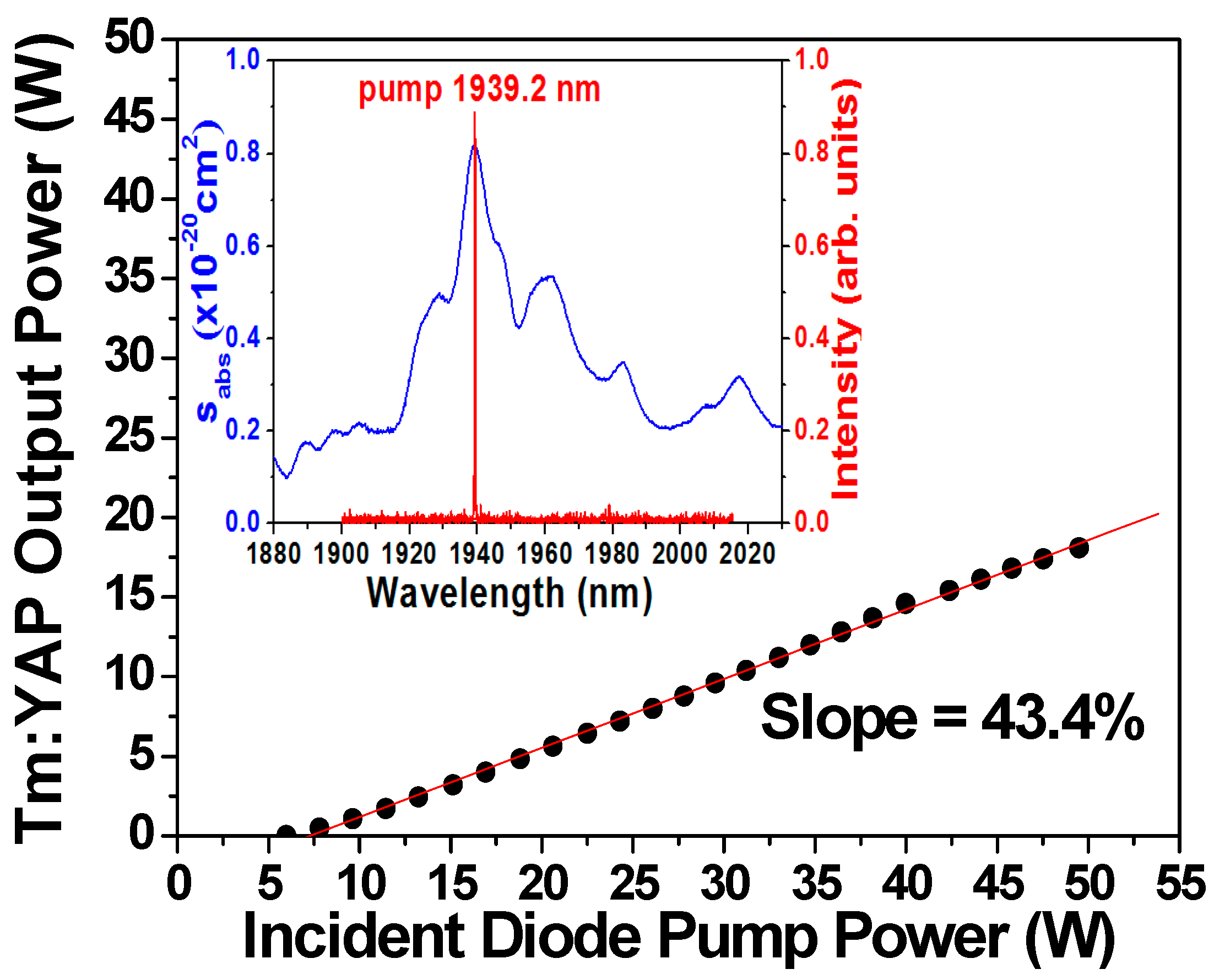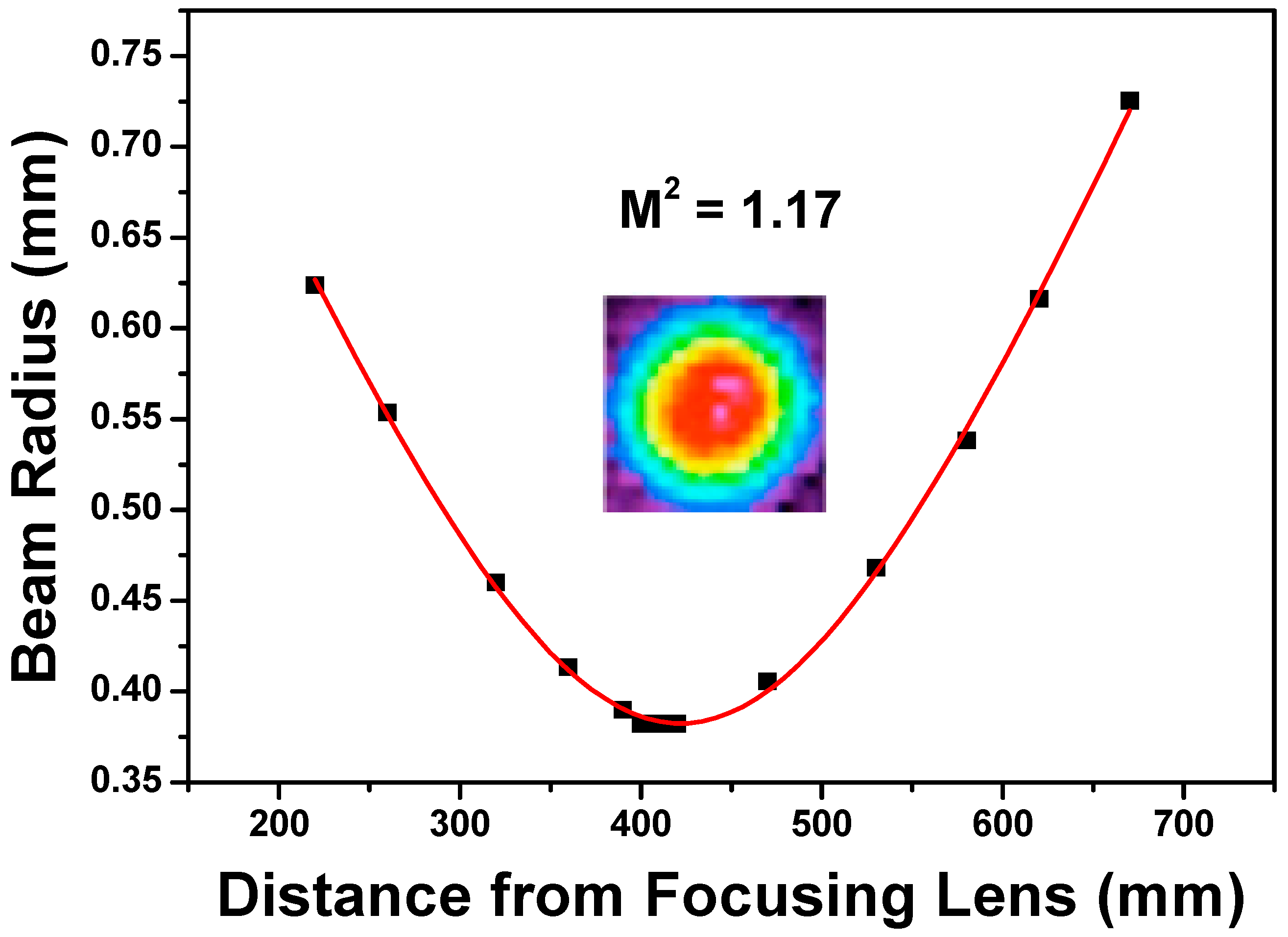1. Introduction
Two-micrometer single-longitudinal-mode (SLM) lasers have become an attractive research topic due to their dramatic advantages. For example, it is safe for eyes and it has fine transparency in the atmosphere [
1,
2]. The 2 μm SLM lasers can serve as efficient sources in optical measurements, such as wind measurement, as well as the measurement of the concentration of atmospheric atoms [
3]. The narrow width and the high quality of the laser are also needed in spectroscopic measurements. There are several traditional methods to obtain SLM lasers, such as microchip lasers [
4], torsion mode cavities [
5], non-planar ring cavities [
6], and coupled cavities with intra-cavity high-loss Fabry–Perot (F–P) etalons [
7], which are the easiest methods of obtaining tunable SLM laser output. The intra-cavity F–P etalons can also provide a higher output power and a narrower width due to its mechanism [
8]. Compared with SLM microchip lasers, the SLM lasers with F–P etalons in laser cavities are more likely to gain a higher efficiency and a higher output power due to the high gain [
9]. The efficiencies of the SLM lasers with intra-cavity F–P etalons are similar to those of the torsion mode cavity and non-planar ring cavity SLM lasers [
10,
11]. However, the torsion mode cavity and non-planar ring cavity SLM lasers are too complicated to realize.
Initial work regarding 2 μm SLM lasers primarily focused on Tm, Ho co-doped crystals. In 1990, Henderson et al. researched Tm, Ho:YAG lasers with intra-cavity etalons and realized SLM laser output with a maximum output of 58 mW [
12]. In 2010, Zhang et al. demonstrated an SLM Tm, Ho:YLF laser with F–P etalons and an output power up to 118 mW was realized [
13]. In 2015, Dai et al. demonstrated an SLM Tm–Ho:YVO
4 laser, and the maximum output power was 95 mW when the central output wavelength was 2051.3 nm [
9]. However, Tm, Ho co-doped lasers need additional cryogenic cooling devices to keep the laser efficient, especially for high-power laser operation [
14]. The cooperative up-conversion losses in Tm, Ho co-doped systems are significant, which make it unsuitable for room temperature operation [
15]. One attractive way to avoid the losses associated with co-doped systems is to separate Tm and Ho ions into different crystals [
16]. Then, a 2 μm Ho single-doped laser can be obtained by a resonant pumping system with laser diode (LD)-pumped Tm-doped lasers. Compared with Tm, Ho co-doped lasers, the Ho single-doped lasers have obvious advantages on account of their high efficiencies and low quantum losses [
17]. Thus, pumping the Ho-doped laser with a Tm laser is a good way to obtain the 2 μm SLM lasers, which has become an attractive issue in the 2 μm SLM laser research field.
As we know, the characteristics of the host materials can affect the output properties of the solid-state laser to a great extent because the host materials determine the thermal, mechanical, and spectral features of the active media. In this paper, Sc
2SiO
5 (SSO) is considered to be a potential Ho single-doped laser gain medium. Compared with the common Ho-doped crystals, such as Ho:YLF and Ho:YAG [
18,
19], there are several outstanding superiorities for the Ho:SSO crystal host, such as large energy splitting (Δ
E = 712 cm
−1) and high thermal conductivity. Additionally, the widths of the absorption and the emission spectra are very large, the full width at half maximum (FWHM) of which are 59 nm and 193 nm, respectively [
20]. It is easier to obtain the high power output for an Ho:SSO laser crystal due to its high thermal conductivity. On the other hand, the SSO crystal is a special laser crystal, which has a negative refractive coefficient. It is obvious that the thermal lens effect, birefringence effects, and crystallographic site distortions can be limited by the negative refractive coefficient [
21].
In this paper, we report an SLM Ho:SSO laser with two intra-cavity F–P etalons, which was pumped by a Tm:YAP laser. The output power reached up to 590 mW at 2111.91 nm when the incident power was 10.2 W. The slope efficiency and the optical conversion efficiency are 9.7% and 5.8%, respectively. To the best of our knowledge, it is the first time that an SLM Ho:SSO laser with intra-cavity F–P etalons has been reported.
2. Experimental Setup
The experimental setup is illustrated in
Figure 1. In the experiment, the concentration of Tm ions is 4 atom %. The size of the crystal is 3 × 3 × 15 mm. Both of the facets are anti-reflection (AR) coated at 792 nm (
R < 0.5%) and 1.94 μm (
R < 0.3%). In order to keep Tm:YAP crystal at 18 °C, a thermoelectric cooler (TEC) was used to precisely control the temperature of the Tm:YAP crystal, which was placed in a copper heat-sink and wrapped in indium foil. The pump source was a laser diode whose maximum output power was 60 W, and the core-diameter of the pigtail fiber was 400 μm (Nlight, Vancouver, WA, US; P4-060 central wavelength: 793.2 nm; FWHM: 1.4 nm). The focal lengths of the two mode-matching lenses are 25 mm and 45 mm, respectively, in order to realize better mode matching. In the center of the laser crystal, the diameter of the pump-beam was nearly 720 μm. The 45° dichroic mirror with high-transmittance (HT) coated at 792 nm (
T ~ 95%) and high-reflectivity (HR) coated at 1.9 μm (
R > 99.5%) was used to deplete the pump light. The inserted Fabry–Perot etalons (1 mm and 6 mm) were used to shift the output wavelength to match the absorption spectrum of the Ho:SSO medium. A plano-concave lens was chosen as the output coupler whose radius of curvature was 300 mm.
To keep the Ho:SSO crystal at 18 °C, a thermoelectric cooler (TEC) was used to precisely control the temperature of the Ho:SSO crystal, which was fixed on a copper heat-sink and wrapped in indium foil. In this experiment, the doping concentration of the Ho:SSO crystal is 0.5 atom %, and the size is 5 × 5 × 13.8 mm. Both of the end surfaces of the crystal are AR-coated (R < 0.3%) at 1.94 μm. The actual single-absorption efficiency of the Ho:SSO crystal was measured to be 58%. A plano-concave resonator was utilized in the Ho:SSO laser. A plano-concave lens was chosen as an output coupler whose transmissions is 15% at 2.1 μm and has a concave curvature radius of 200 mm. The 45° dichroic mirror is HR coated (R > 99.5%) at 1.94 μm and HT (T > 94%) at 1.94 μm. Near the center of the laser crystal, the diameter of the pump beam was about 480 μm. The transmission of both flat surfaces is 99.2% at 2.1 µm by AR coated with SiO2 infrasil. In order to achieve SLM laser output, two F–P etalons (1 mm and 6 mm) made by YAG materials with 20% reflection loss were used. According to the following expressions, ∆υc = c/2nd, where ∆υ is the free spectral range (FSR), and d is the thickness of the etalon. The FSR of the 1 mm and 6 mm etalons are calculated to be 8.24 ×1010 Hz and 1.37 × 1010 Hz, respectively. The mode selection effect of the 6 mm etalon has a narrower transmission curve, which is better than that of the 1 mm etalon. Thus, the 1 mm etalon was inserted first, and then the 6 mm one. By adjusting the angle of the two etalons, the other modes were suppressed due to high losses, and only one mode achieved the highest gain in the peak of the transmittance.
3. Experimental Results
The performance of the Tm:YAP laser pumped by a diode laser is shown in
Figure 2. When the incident pump power was 49.5 W, the maximum continuous-wave (CW) output power of 18.1 W was obtained. At the same time, the optical efficiency and the slope efficiency were 31.8% and 43.4%, respectively, which were calculated by linear fitting of the experimental data with respect to the incident diode laser power. A spectrum analyzer (WA-650, EXFO, Quebec, PQ, Canada) combined with an wave meter (WA-1500, EXFO, Canada) was used to measure the output spectrum of the Tm:YAP laser. The central wavelength of the Tm:YAP laser was 1939.2 nm, which matched the absorption line of the Ho:SSO, as shown in
Figure 2. The absorption cross section
σabs is 0.79 × 10
−20 cm
2 at the pump wavelength.
The laser performance under the multi-mode operation is shown in
Figure 3. In the experiment, a power meter (Power Max PS19, Coherent, Portland, OR, USA) was used to measure the output power of the Ho:SSO laser. For the Ho:SSO laser, the output power reached a maximum of 2.98 W with an incident power of 16.2 W. At the same time, the optical-optical conversion efficiency was 18.4%. By linear fitting of the experimental data, the slope efficiency was calculated to be 23%. The spectrum analyzer (Model 721, Bristol Instruments, Victor, NY, USA) was used to record the laser spectrum when the incident pump power was 16.2 W. The central wavelength was 2111 nm with an FWHM of 1.1 nm. The result is shown in
Figure 3.
The operation in the free-running mode was immediately achieved for the Ho:SSO laser developed in this study. A Fabry–Perot interferometer whose FSR is 1.5 GHz was chosen to measure the laser mode. The typical multi-mode operation is shown in
Figure 4. The PZT’s driving voltage of the Fabry–Perot interferometer is expressed by the yellow line “voltage.” Many peaks were observed in a free spectral range of 1.5 GHz, suggesting that the laser was operating in multi-mode. In order to realize the single-longitudinal mode of operation, two Fabry–Perot etalons with different thicknesses (1 mm and 6 mm) were inserted into the laser cavity. The thinner etalon was used to suppress other mode oscillations, and the thicker etalon was used to compress the laser line width even further. The SLM operation can be realized by optimizing the angle of the Fabry–Perot etalons.
Figure 5 shows that the Ho:SSO laser operates in an SLM. The voltage of the free spectral range was about 20 V. There were only two peaks in the 1.5 GHz free spectral range.
Figure 6 shows the laser performance of the SLM Ho:SSO laser. In the experiment, a power meter was used for measuring the output power of the Ho:SSO laser. When the incident power was 10.2 W, we obtained a maximum output power of 590 mW at 2111.91 nm. At the same time, the slope efficiency and the optical conversion efficiency were 9.7% and 5.8%, respectively. The laser spectrum was recorded by the spectrum analyzer (0.7 pm resolution) when the incident pump power was 10.2 W. The central wavelength was 2111.91 nm with an FWHM of 0.11 nm. The result is shown in
Figure 7.
The beam quality factor
M2 of the SLM Ho:SSO laser, using the travelling knife-edge method, was measured at 2111.91 nm, where the output power was the highest. The result can be seen in
Figure 7. The data were fitted according to the Gaussian beam propagation equation and
M2 was calculated to be 1.17.











